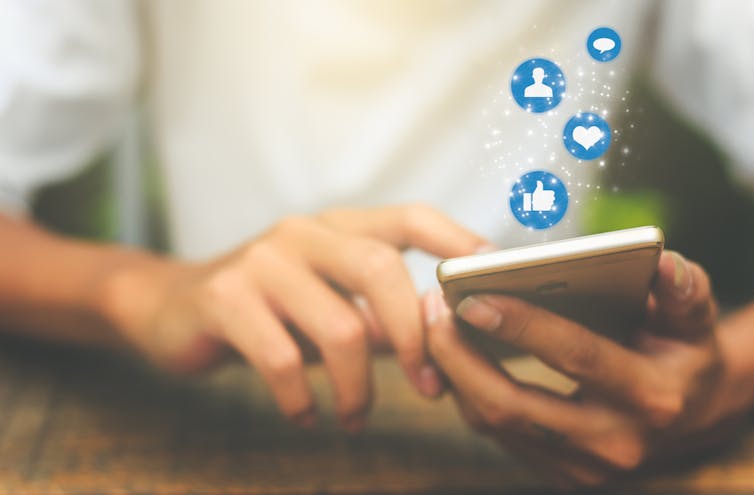Why Twitter's cute, heart-shaped 'like' button is not so harmless
- Written by A. Trevor Sutton, Ph.D. Student in Doctrinal Theology, Concordia Seminary
Jack Dorsey, Twitter’s founder and CEO, was recently reported to have questioned[1] how the site “incentivizes people to want (the number of likes on their posts) to go up.” He also said that “he was not a fan of the heart-shaped (‘like’) button and that Twitter would be getting rid of it ‘soon.’” Twitter has since released a statement[2] indicating that there are no immediate plans to remove the “like” button.
Whatever the future of Twitter’s “like” button may be, as a scholar of social media and religion[3] I’d argue that the cute little heart-shaped button on Twitter and Facebook is far more impactful than it appears.
How people use the ‘like’ button
The “like” button is not there by accident. Instead, this one-click feature exists as an intentional design decision.
Like most big tech companies, Twitter has an entire department[4] dedicated to understanding users. Every feature and font, based on their research, is there to maximize the overall user experience.
The design decisions furtively influence users’ feelings and behaviors. Chris Nodder[5], a user experience researcher and the author of “Evil by Design,”[6] explains how designers must always ask the question, “How do we influence behavior through the medium of software?”
In other words, design decisions are made not only to improve a users’ experience but also influence their behaviors. The “like” button is one example.
While the heart-shaped button is seemingly only for expressing appreciation for the content of a social media post, researchers have determined that people use the button for many other reasons.
A team of researchers[7], for example, found that users in the United States often chose to like something for bonding purposes rather than simply liking the content.
Another study of Facebook users[8] found that the “like” button is used to maintain relationships with existing friends or to develop new relationships. People may use the “like” button as a way to publicly show closeness to another person, or even as an effort toward dating someone.
The point being that the “like” button does far more than just express how much a person likes a particular picture or post.
Not so harmless
Research has also shown that the “like” button is not entirely harmless.
Social networking sites are powerful tools for building relationships. Nevertheless, research has shown that certain social media features can adversely affect users.
For instance, a study found that impersonal gestures[9] such as the one-click “like” communication may not promote user well-being. According to Facebook researcher Moira Burke[10] and Robert Kraut[11], an emeritus professor at Carnegie Mellon University, “simply reading about friends, receiving text communication from weak ties, and receiving one-click communication did not affect well-being.” On the other hand, more personal and direct communication such as a direct message or personalized comment can have an impact on user well-being.
 The number of ‘likes’ on a post can generate feelings of envy.
13_Phunkod[12]
The number of ‘likes’ on a post can generate feelings of envy.
13_Phunkod[12]
A particularly harmful byproduct of the “like” button is found in the way social networking sites foster negative social comparisons. A review of research on the topic[13] has found that social media use correlates with measurable increases in envy and depression.
These feelings of envy can take two different forms: malicious envy and benign envy. Malicious envy involves resentment and a desire to harm the other person. Benign envy involves admiration and a desire to obtain what the other person possesses.
One of the studies in the review[14] involved 194 college-aged Facebook users in Germany. In this study, researchers found that “the closer the relationship, the more a Facebook user will experience benign envy.”
These digital showrooms allow people to present the best version of themselves for everyone else to see. Often, people use the number of likes to judge others and themselves. That little heart-shaped button becomes a publicly quantifiable measure of social support[15].
According to this research[16], the “like” button works as a “mechanism to compare oneself with others.” The number of “likes,” make social support quantifiable. It can then be easily viewed for making social comparisons.
Ripple effects of social networking sites
Given the impact of social networking sites on the feelings and behaviors of billions of users, I believe there needs to be an ethical component to designing these technologies.
As Twitter is busy “rethinking everything,” the company would do well to think about how the platform is shaping the feelings and behaviors of its users.
Michigan Tech humanities scholar Robert Johnson[17], in his book, “User-Centered Technology[18],” writes how technologies have “ripple effects” that “shape culture in defining ways.”
The same argument is true for social networking sites. As such, every design feature – even that little heart-shaped button – must be carefully scrutinized.
References
- ^ reported to have questioned (www.telegraph.co.uk)
- ^ statement (twitter.com)
- ^ social media and religion (divinity.uchicago.edu)
- ^ department (careers.twitter.com)
- ^ Chris Nodder (nodder.com)
- ^ “Evil by Design,” (www.oreilly.com)
- ^ team of researchers (doi.org)
- ^ study of Facebook users (dx.doi.org)
- ^ study found that impersonal gestures (doi.org)
- ^ Moira Burke (research.fb.com)
- ^ Robert Kraut (hcii.cmu.edu)
- ^ 13_Phunkod (www.shutterstock.com)
- ^ review of research on the topic (doi.org)
- ^ studies in the review (doi.org)
- ^ measure of social support (doi.org)
- ^ research (doi.org)
- ^ Robert Johnson (www.mtu.edu)
- ^ User-Centered Technology (www.sunypress.edu)
Authors: A. Trevor Sutton, Ph.D. Student in Doctrinal Theology, Concordia Seminary
Read more http://theconversation.com/why-twitters-cute-heart-shaped-like-button-is-not-so-harmless-107319

